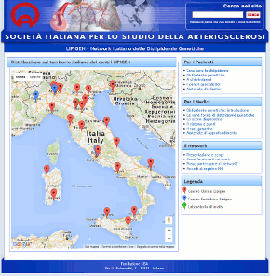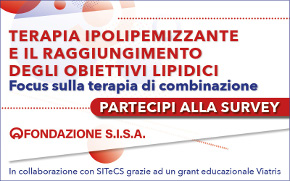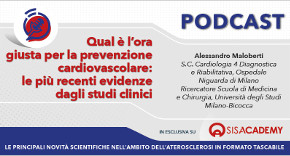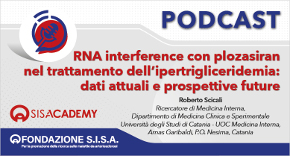 Rivista in lingua italiana
Rivista in lingua italiana
riservata ai Soci SISA
Ultimo numero:
Anno 16 • N.1/2025
SISANews
Le microparticelle rilasciate dalle placche aterosclerotiche favoriscono il reclutamento dei monociti
Le placche aterosclerotiche contengono grandi quantità di microparticelle che vengono liberate come piccole vescicole costituite da membrane cellulari durante l'attivazione cellulare o l'apoptosi. Le microparticelle isolate dalle lesioni aterosclerotiche umane originano da varie cellule, inclusi macrofagi, linfociti, eritrociti, cellule muscolari lisce e cellule endoteliali. Mantengono sulla loro superficie molte delle proteine associate alle membrane delle cellule originarie e questo fa sì che svolgano varie azioni, tra cui il reclutamento cellulare, grazie alla presenza di molecole di adesione (ICAM-1). L'ICAM-1 verrebbe trasferita dalle micro particelle alle cellule endoteliali e questo faciliterebbe l'adesione dei monociti circolanti alla parete endoteliale e la loro migrazione negli strati sottoendoteliali. L'accumulo di microparticelle nella lesione aterosclerotica contribuirebbe perciò alla progressione della placca con il reclutamento di cellule infiammatorie nella lesione.
![]()
Microparticles from human atherosclerotic plaques promote endothelial ICAM-1-dependent monocyte adhesion and transendothelial migration
Rautou PE, Leroyer AS, Ramkhelawon B, Devue C, Duflaut D, Vion AC, Nalbone G, Castier Y, Leseche G, Lehoux S, Tedgui A, Boulanger CM.
Circ Res 2011;108:335-43
RATIONALE AND OBJECTIVE: Membrane-shed submicron microparticles (MPs) released following cell activation or apoptosis accumulate in atherosclerotic plaques, where they stimulate endothelial proliferation and neovessel formation. The aim of the study was to assess whether or not MPs isolated from human atherosclerotic plaques contribute to increased endothelial adhesion molecules expression and monocyte recruitment.
METHOD AND RESULTS: Human umbilical vein and coronary artery endothelial cells were exposed to MPs isolated from endarterectomy specimens (n=62) and characterized by externalized phosphatidylserine. Endothelial exposure to plaque, but not circulating, MPs increased ICAM-1 levels in a concentration-dependant manner (3.4-fold increase) without affecting ICAM-1 mRNA levels. Plaque MPs harbored ICAM-1 and transferred this adhesion molecule to endothelial cell membrane in a phosphatidylserine-dependent manner. MP-borne ICAM-1 was functionally integrated into cell membrane as demonstrated by the increased ERK1/2 phosphorylation following ICAM-1 ligation. Plaque MPs stimulated endothelial monocyte adhesion both in culture and in isolated perfused mouse carotid. This effect was also observed under flow condition and was prevented by anti-LFA-1 and anti-ICAM-1 neutralizing antibodies. MPs isolated from symptomatic plaques were more potent in stimulating monocyte adhesion than MPs from asymptomatic patients. Plaque MPs did not affect the release of interleukin-6, interleukin-8, or MCP-1, nor the expression of VCAM-1 and E-selectin.
CONCLUSION: These results demonstrate that MPs isolated from human atherosclerotic plaques transfer ICAM-1 to endothelial cells to recruit inflammatory cells and suggest that plaque MPs promote atherosclerotic plaque progression.

Area Soci
Eventi
39° Congresso Nazionale
 39° Congresso Nazionale
39° Congresso NazionaleRoma, 23-25 novembre 2025
Save the date




 Spring Meeting Gruppi Giovani SID, SIGG, SIIA, SIMI, SIPREC, SISA
Spring Meeting Gruppi Giovani SID, SIGG, SIIA, SIMI, SIPREC, SISARimini, 6-8 aprile 2025
[continua a leggere]
 SISA LIPID ACADEMY - Corso avanzato di lipidologia clinica
SISA LIPID ACADEMY - Corso avanzato di lipidologia clinicaModena, 4-5 Luglio 2024
[continua a leggere]Giornale Italiano Arteriosclerosi
HoFH today
 Rivista Italiana della
Rivista Italiana della
Ipercolesterolemia
Familiare Omozigote
Anno 6 • N.1/2024
Rivista NMCD
Diateca
[continua a leggere]
[continua a leggere]
Newsletter
il vostro indirizzo di posta elettronica
Progetto LIPIGEN

Nuovo sito dedicato al Progetto LIPIGEN
Progetto LIPIGEN - Vecchio portale
E' necessario essere loggati come utente
Lipigen per poter accedere alla pagina
PROject Statin Intolerance SISA
PROSISA – PROject Statin Intolerance SISA
E' necessario essere loggati come utente
PROSISA per poter accedere alla pagina
GILA - Lipoprotein Aferesi
Gruppo Interdisciplinare Lipoprotein Aferesi
(Accesso Gruppo GILA-Lipoprotein Aferesi)
E' necessario essere loggati come utente del Gruppo GILA per poter accedere
Gruppo Interdisciplinare Lipoprotein Aferesi
(Documentazione ad accesso libero)
Pagina informativa per medici e pazienti










